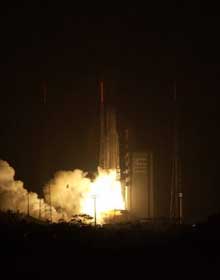Europe’s environmental eye soars into orbit

Envisat soars into orbit <br>
The eagerly awaited launch of ESA’s Envisat environmental monitoring satellite took place in Kourou, French Guiana, today at 22:07:59 hrs Kourou time (02:07:59 hrs CET). Envisat’s spectacular night-time launch also marked the return to business for Europe’s Ariane 5 launcher.
Lift-off was witnessed by dozens of cheering engineers, scientists and project members at the launch site and at ESA centres across Europe. Rising into a clear sky, the Ariane 5 propelled the Envisat towards a lofty vantage point some 800 km above the Earth’s surface.
Envisat – the most ambitious Earth observation satellite – follows in the footsteps of ESA’s successful ERS-1 and ERS-2 missions launched in the 1990s. It will boost Europe’s capacity to take part in the study of the Earth and its environment by supporting critical research programmes on global warming and climate change issues, as well as performing crucial tasks such as pollution and disaster monitoring .
After a flawless lift-off, the Ariane 5 placed Envisat into sun-synchronous orbit, allowing ESA ground controllers at the space operations centre in Darmstadt, Germany, to take full control for the first time of the most complex satellite ever built in Europe.
“This has been a particularly exciting day for ESA and the European space community as a whole,” said José Achache, ESA’s Director of Earth Observation. “Europe is taking an important lead in global observations for worldwide environmental needs and Envisat is going to make a significant impact on the future of remote sensing of the Earth”.
“The ten instruments on board Envisat, more than on any other satellite, cover a wide spectrum of phenomena, delivering evidence of the interactions between the atmosphere, the ocean, the polar ice caps, the vegetation as well as human activity at the surface of the Earth. We will be able to trace the smallest changes to the Earth’s surface anywhere on the globe. The importance of this mission has triggered great interest in the Earth-science community, both at a European level and worldwide.”
Commenting from Europe’s spaceport in French Guiana, Jacques Louet, ESA’s Envisat Programme Manager, admitted that there was a certain risk to pack so much know-how into just one satellite. “However, if we want to have a comprehensive understanding, we must follow this path”, he said.
Given its sheer size, Envisat has involved almost all of Europe’s space industries in the development of numerous advanced technologies, particularly for the payload.
Envisat is expected to be declared operational after just a few weeks, once its payload has been checked out and the various data-recovery links set up. Then the satellite’s six-month long commissioning phase will begin, ensuring that the ten instruments are operating as specified and that we can start delivering validated products to our users.
“Now Envisat is in orbit, the culmination of many years’ work really begins and we are looking forward to the environmental benefits the satellite is going to bring to Europe,” added Mr Achache.
The successful launch of Envisat also marked a return to service for the Ariane 5 launcher. It’s upper stage has undergone over 300 tests since last summer, following the failure of flight Ariane 510 to insert two satellites, including ESA’s Artemis, in the correct orbits. However, thanks to ion propulsion, the Artemis mission is turning into a success story, as the satellite is making its way to geostationary orbit, and nominal operations could start this summer.
For further information, please contact:
ESA Media Relations
Tel: +33.(0)1.5369.7155
Fax: +33.(0)1.5369.7690
Media Contact
All latest news from the category: Ecology, The Environment and Conservation
This complex theme deals primarily with interactions between organisms and the environmental factors that impact them, but to a greater extent between individual inanimate environmental factors.
innovations-report offers informative reports and articles on topics such as climate protection, landscape conservation, ecological systems, wildlife and nature parks and ecosystem efficiency and balance.
Newest articles

Superradiant atoms could push the boundaries of how precisely time can be measured
Superradiant atoms can help us measure time more precisely than ever. In a new study, researchers from the University of Copenhagen present a new method for measuring the time interval,…

Ion thermoelectric conversion devices for near room temperature
The electrode sheet of the thermoelectric device consists of ionic hydrogel, which is sandwiched between the electrodes to form, and the Prussian blue on the electrode undergoes a redox reaction…

Zap Energy achieves 37-million-degree temperatures in a compact device
New publication reports record electron temperatures for a small-scale, sheared-flow-stabilized Z-pinch fusion device. In the nine decades since humans first produced fusion reactions, only a few fusion technologies have demonstrated…





















